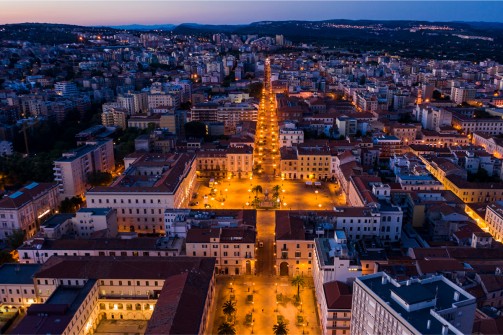Sassari, located in the center of the vast northwestern region of Sardinia, is with its 130,000 inhabitants the second largest city on the island.
The ancient name of Sassari, Thatari, first appears in 1113, in an ancient register of the monastery of St. Peter of Silki. Its territory offers numerous evidences of the presence of man since the ancient Neolithic, up to and including the Copper Age, to which the pre-Nuragic altar of Monte d’Accoddi dates. The presence of numerous sites from the Nuragic period reveals signs of the ancient civilization that developed in Sardinia during the Bronze Age and early Iron Age, while the Roman remains reveal signs of Roman rule (238 B.C. – 460/467 A.D.).
In 1236 the city was established as a free municipality, and then promulgated during the 13th century the “Sassaresi Statutes,” which regulated the political and administrative life of the city. The alliance entered into first with Pisa and then with Genoa fostered a flourishing economic and cultural growth, evidenced by the construction of building works including the city walls and the town hall. A royal city since 1331, Sassari still retains signs of Aragonese and Spanish rule, which lasted four centuries and ended in 1713 with the Treaty of Utrecht. After a brief Austrian rule, Sardinia was ceded to the Savoy in 1720. Time and the succession of historical events help to define the characteristic features of the city of Sassari, which offers itself to those who know how to look and discover it. The articulated historic center encloses within the medieval city walls, dating back to the 13th century, monuments of great architectural value. Still visible signs of the ancient walls can be found in Piazza Sant’Antonio and along Corso Trinità, near the 17th-century Rosello Fountain, the city’s symbolic monument. Along Corso Vittorio Emanuele II and in the streets of the center, among striking archivolts and ancient pavements stand the most representative religious and civic buildings. Among the many churches is the Cathedral of St. Nicholas, whose majestic Baroque facade dates from the 18th century. Important civil architecture enriches a visit to the city and tells its story: these include the neoclassical Palazzo di Città, home of the City Museum; the Ducal Palace, one of the greatest examples of civil architecture with public functions; the Palazzo d’Usini and the Palazzo della Frumentaria; and the Palazzo dell’Insinuazione. Among the narrow alleys are the town squares: piazza Duomo, piazza del Comune, piazza Tola, piazza Azuni and piazza Castello, where the excavations of the Barbacane restore to the town’s memory what remains of the ancient castle demolished in the late 19th century. Castello Square marks the junction between the historic center and the 19th-century expansion of the city, symbolically represented by the Palace of the Province overlooking the Piazza d’Italia in which stands the monument to King Victor Emmanuel II. A short distance away, along Via Roma, is the “G. A. Sanna” National Museum, a prestigious museum institution for the island. Sassari is the city where two important events take place: the Candelieri festival, recognized by UNESCO as a World Heritage Site, and the Sardinian Cavalcade.


